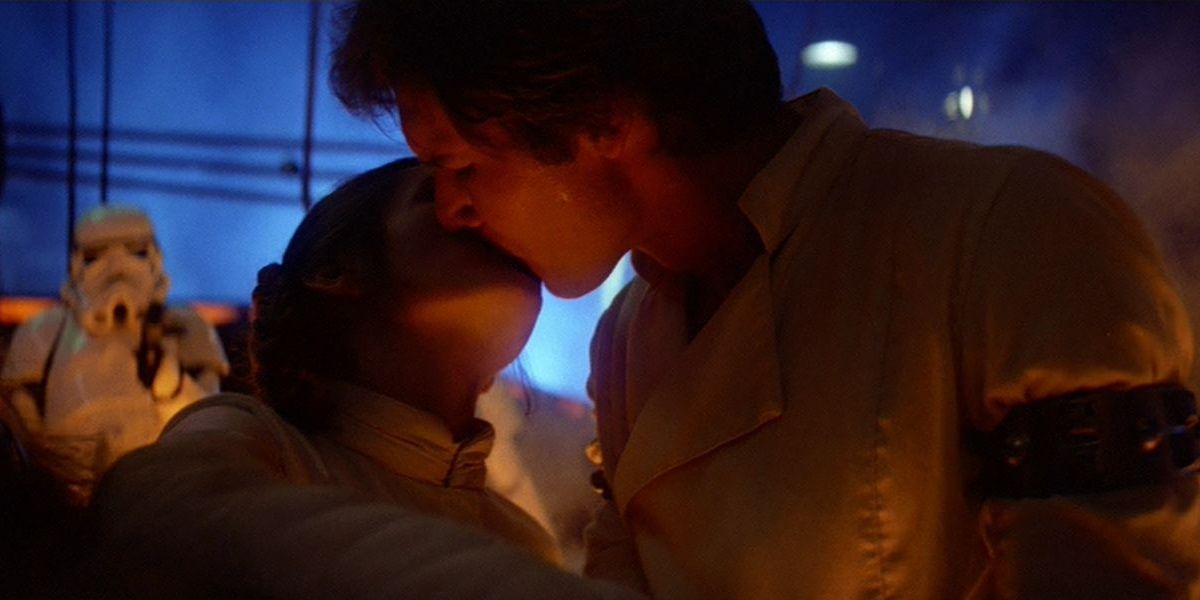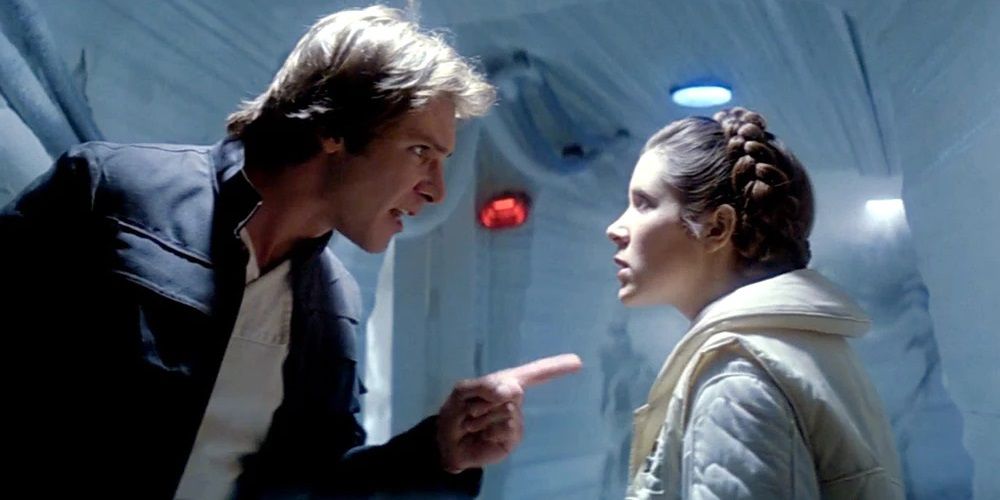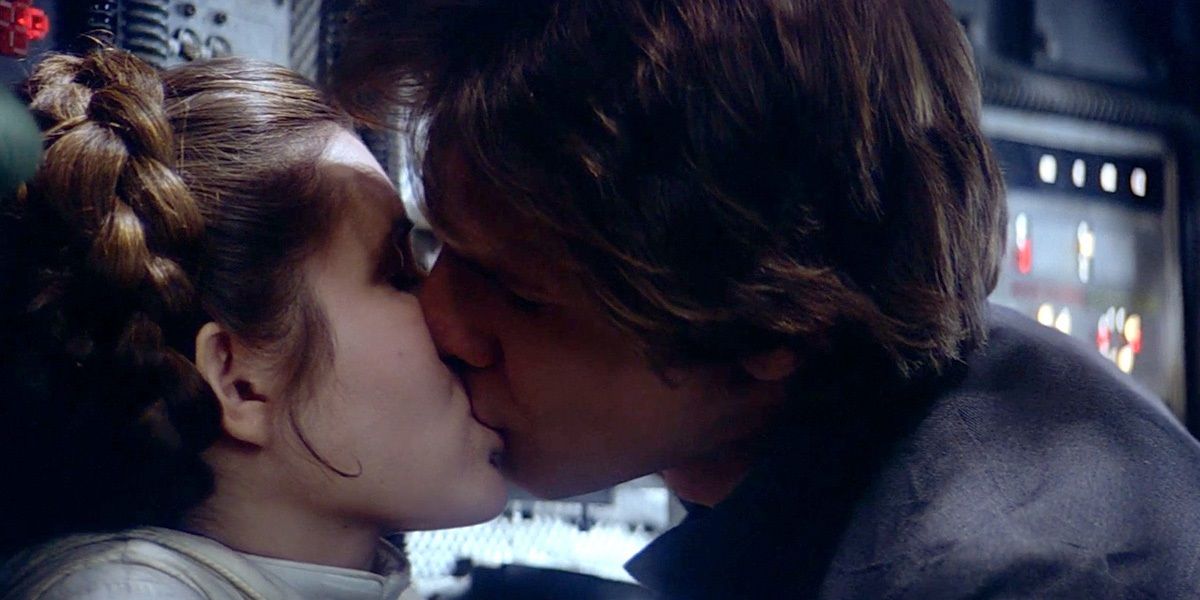
Since George Lucas himself has admitted that romantic dialogue is one of his weaknesses, the Star Wars saga has always suffered in the love department. From toxic relationships to incest, Star Wars love stories have never been one of the movies’ greatest strengths. But everyone’s favorite galaxy far, far away does have one love story that rings true, still holds up today (more or less), and feels right at home in Lucas’ pulpy universe: Han Solo and Leia Organa.
Not all of Star Wars’ non-Han and Leia romances are as woefully mishandled as Anidala or Reylo – there’s a handful of great romantic arcs in The Clone Wars – but Han and Leia still share the defining love story of the Star Wars universe. Their relationship is one of the few beloved elements of the original trilogy that wasn’t completely destroyed by Disney’s Star Wars sequels. The Force Awakens’ revelation that they broke up off-screen was pretty disappointing, but Harrison Ford and Carrie Fisher still had just as much chemistry as they did 30 years earlier and nailed the heartwarming reunion scene (and heartbreaking farewell scene). Give or take a couple of details like Leia consoling Rey after Han’s death instead of Chewie, their timeless arc from the original trilogy remains intact.
RELATED: Was Han Solo A Bad Influence On Chewbacca?
Where Han and Leia were the main romance in the original trilogy, Anakin and Padmé’s forbidden love was the main romance of the prequels and Rey and Ben Solo’s toxic Force dyad took over the sequels. Criticism of Anidala sounds like a broken record now, because it’s been one of the most polarizing elements of the trilogy since it first hit theaters. Scenes like “I don’t like sand” are widely recognized for their cringe factor. But at least Anakin and Padmé’s romance served a purpose in the plot. The sequel trilogy’s Reylo storyline, on the other hand, always felt forced. The Force Awakens set up Finn as Rey’s love interest and Kylo Ren as her mortal enemy, but The Last Jedi sidelined Finn and forced a love story between Rey and Kylo, turning well-placed hatred into misguided affection. Then, The Rise of Skywalker doubled down on this dynamic to pander to the Reylo shippers in the audience. It’s only thanks to Daisy Ridley and Adam Driver’s chemistry that it’s even watchable.

The original trilogy gave Han and Leia’s love story plenty of room to breathe. When they first meet on the Death Star in the original 1977 movie, they hate each other. But, unlike Rey warming to Ben’s genocidal tendencies, it was believable that they would eventually come to care about each other. After Han proves his capacity for heroism in the Battle of Yavin, Leia realizes there might be more to the Corellian scoundrel than she initially thought. The opening scenes of The Empire Strikes Back give Han and Leia plenty of reasons to love each other and plenty of reasons to hide those feelings, then the inciting incident puts them in the Millennium Falcon together on the lam from the Imperial fleet, forcing them to confront their romantic tension.
While Anidala’s theme “Across the Stars” has sweeping orchestrations befitting a Shakespearean tragedy, “Han Solo and the Princess” remains John Williams’ best composition capturing the complex emotions of an on-screen romance. A lot of Han and Leia’s scenes in Empire came from an early draft by Queen of Space Opera Leigh Brackett, who had previously crafted the romantically charged dynamics of Marlowe and Vivian in The Big Sleep and Chance and Feathers in Rio Bravo.

The arc of Han and Leia’s emotions in Empire rings much truer than that of Anakin and Padmé or Rey and Ben ever did. Their love story anchors some of the most memorable moments in Empire, from their bickering masking affection at the Hoth base to their first kiss interrupted by C-3PO. And, of course, it all culminates in one of the movie’s greatest moments (on par with Yoda lifting the X-wing, but not quite on the same level as “I am your father”) when Han is about to be frozen in carbonite. Leia says, “I love you,” and Han, cool as ever, replies, “I know.” In the original script, Han was actually supposed to say, “I love you, too,” but Harrison Ford didn’t think Han would say that, so he changed it to what has since become one of the most iconic movie quotes of all time.
With a decidedly lighter tone than Empire, Return of the Jedi gave less of a spotlight to Han and Leia’s love story to make way for more Ewok antics. But it still provided a satisfying conclusion to their arc. After the devastating final moments of Empire, Leia infiltrates Jabba’s palace to save Han. In the final battle on Endor, when Leia reveals the concealed blaster that will save Han’s life, he says, “I love you,” and this time, she’s the one who says, “I know,” before blowing away a couple of Stormtroopers. The emotional climax of Return of the Jedi is Darth Vader’s redemption in his son’s eyes, but the movie also gets Han and Leia to a happy place after all the tragedy and heartbreak they’ve been through.
MORE: Return Of The Jedi Was The Perfect Ending For The Skywalker Saga

